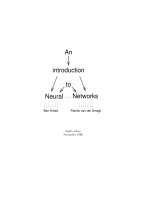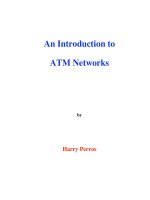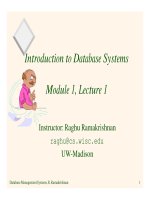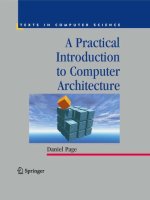ECE CS 372 introduction to computer networks lecture 1 chapter 1
Bạn đang xem bản rút gọn của tài liệu. Xem và tải ngay bản đầy đủ của tài liệu tại đây (1.03 MB, 70 trang )
Course Overview
Spring 2012
ECE/CS 372 Introduction to Computer Networks
Lecture 1
School of Electrical Engineering and Computer Science
Oregon State University
Chapter 1, slide:
1
Lecture/Office/Lab Hours
Course website
/>rks.htm
Please write down this URL—all course material and information will be
provided thru this site
Lectures
Everyday 1-1:50pm
Instructor
Yousef Qassim ()
Office hours: TR 2:30-3:20pm @KEC lounge
Chapter 1, slide:
2
Lecture/Office/Lab Hours
Lab Assistant
Location: Dearborn 205
Lab hours: to help you with your labs
205 DEAR
Information can be found in course’s website
Lab
Location: Dearborn 205
Access code: will be written on board
Chapter 1, slide:
3
Prerequisite/Textbook
Prerequisite:
CS or ECE 271 or an equivalent course
Basic Linux familiarity
Textbook
Textbook is Required
Computer Networking: A Top-Down Approach
Featuring the Internet, 6th Edition, Games F.
Kurose, Keith W. Ross
Chapter 1, slide:
4
Grading Policy
Assignments: 15%
Each student must hand in one copy
5 assignments: approx. 1 every two weeks
Labs: 15%
Each student must hand in one copy
5 labs: approx. 1 every two weeks
One midterm exam: 30%
Final exam: 40%
Chapter 1, slide:
5
Topics To Be Covered
Architecture of the Internet, and network protocols
Delay analysis
Packet-switching and circuit-switching
Congestion and flow control: TCP
Routing algorithms: IP and datagram
Data link layers and Ethernet: ARP, CSMA/CD
Medium access control and local area networks
Chapter 1, slide:
6
Lectures & assignments
Objective
Deep understanding of basic and fundamental
networking concepts, architectures, and philosophies
IMPORTANT: this course is NOT about setting up
your router at home, or writing a twitter program!!
Approach: how to do well in this course
Easy: attend ALL lectures and do ALL assignments
Do your assignments individually
Do NOT miss any Bonus Quiz (i.e., do not miss class)
Some hw problems will be solved in class: this gives
you the opportunity to clarify things further
Chapter 1, slide:
7
Labs
Objective
Understand how Internet protocols work
Force network protocols to perform certain actions
Observe and analyze protocols’ behavior
Approach
Software tool: Wireshark
already installed in Lab DEAR 205
To run, type: sudo wireshark then enter your eecs psswd
Allows you to sniff and analyze traffic
sent/received from/by your end system: real
measurement of Internet traffic
Chapter 1, slide:
8
Chapter 1: Introduction
Our goal:
learn basic network
terminologies
more depth, detail
later in course
approach:
use Internet as
example
Acknowledgement: slides drawn heavily from Kurose & Ross
Chapter 1, slide:
9
Chapter 1: roadmap
1 What is the Internet?
2 Network edge
3 Network core
4 Internet structure and ISPs
5 Protocol layers, service models
6 Delay & loss in packet-switched networks
Chapter 1, slide: 10
What’s the Internet: a “service” view
infrastructure
enables distributed apps:
communication
Enables apps to communicate
Web, email, games, ecommerce, file sharing
communication services
provided to apps:
Offers services
Chapter 1, slide: 11
What’s the Internet: “nuts and bolts” view
millions of connected
computing devices: called
hosts or end systems
e.g., fiber, copper, radio,
satellite
mobile
local ISP
regional ISP
forward packets (chunks
of data)
communication links
workstation
server
routers & switches:
e.g., Laptops, workstations
running network apps
router
company
network
Chapter 1, slide: 12
What’s the Internet: “nuts and bolts” view
Internet standards
IETF
(Internet Eng. Task Force)
• RFC: Request for comments
router
server
mobile
local ISP
IEEE: for links/hardware
E.g., Ethernet
regional ISP
network protocols
workstation
control sending/receiving of
messages
e.g., TCP, IP, HTTP, FTP, PPP
company
network
Chapter 1, slide: 13
What’s a protocol?
a human protocol and a computer network protocol:
Hi
TCP connection
request
Hi
TCP connection
response
Got the
time?
Get />
2:00
<file>
time
Chapter 1, slide: 14
What’s a protocol?
human protocols:
“what’s the time?”
“I have a question”
introductions
… specific msgs sent
… specific actions taken
when msgs received,
or other events
network protocols:
machines rather than
humans
all communication
activity in Internet
governed by protocols
protocols define (1) format,
order of msgs sent and
received among network
entities, and (2) actions
taken on msg
transmission, receipt
Chapter 1, slide: 15
Chapter 1: roadmap
1 What is the Internet?
2 Network edge
3 Network core
4 Internet structure and ISPs
5 Protocol layers, service models
6 Delay & loss in packet-switched networks
Chapter 1, slide: 16
A closer look at network structure:
network edge:
applications and
hosts
network core:
routers
network of
networks
access networks,
physical media:
communication links
Chapter 1, slide: 17
The network edge: service models
end systems (hosts):
run application programs
e.g. Web, email
at “edge of network”
client/server model
client host requests, receives
service from always-on server
e.g. Web browser/server;
email client/server
peer-to-peer model:
minimal (or no) use of
dedicated servers
e.g. Skype, BitTorrent, KaZaA
Chapter 1, slide: 18
Chapter 1: roadmap
1 What is the Internet?
2 Network edge
3 Network core
4 Network access and physical media
5 Internet structure and ISPs
6 Protocol layers, service models
7 Delay & loss in packet-switched networks
Chapter 1, slide: 19
The Network Core
mesh of interconnected
routers
the fundamental
question: how is data
transferred through net?
circuit switching:
dedicated circuit per
call: telephone net
packet-switching: data
sent thru net in
discrete “chunks”
Chapter 1, slide: 20
Network Core: Circuit Switching
End-end resources
reserved for “call”
dedicated resources: no
sharing
call setup required
circuit-like (guaranteed)
performance
same path for all chunks
Chapter 1, slide: 21
Network Core: Circuit Switching
network resources
(e.g., bandwidth)
divided into “pieces”
allocated pieces per call
no sharing
resource piece idle if
not used by owning call
Chapter 1, slide: 22
Network Core: Circuit Switching
Two ways of dividing bandwidth into “pieces”
frequency division
time division
Chapter 1, slide: 23
Circuit Switching: FDM and TDM
Example:
Freq. Division Multiplx. (FDM)
4 users
frequency
time
Time Division Multiplx. (TDM)
frequency
time
Chapter 1, slide: 24
Network Core: Packet Switching
100 Mb/s
Ethernet
A
B
C
1.5 Mb/s
each end-to-end data stream is divided into packets
no dedication/reservation: all streams share resources
no setup is required
resources used as needed
each packet uses full link bandwidth
aggregate resource demand can exceed capacity
no guarantee
Chapter 1, slide: 25









